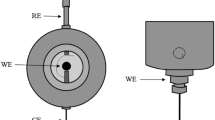Abstract
A clean alternative method for the determination of chemical oxygen demand (COD) was developed using a copper electrode as an electrocatalytic sensor. The measuring principle is based on oxidation current of organic compounds in the wastewater. The effects of important experimental conditions, such as electrolytic solution concentration and potential scan rate, on analytical performance have been investigated. Analytical linear range of 53.0–2,801.4 mg l−1 COD with detection limit of 20.3 mg l−1 COD was achieved. The procedure was successfully applied to the COD determination in wastewater from soft industries. The results obtained using the proposed method were in good agreement with those obtained using the conventional (i.e., dichromate) COD method. In this fashion, the COD value of a sample can be determined in a simple, rapid, accurate manner, and the end products do not contain toxic metals.




Similar content being viewed by others
References
Association of Official Analytical Chemists (1990) Official methods of analysis, 15th edn. Kenneth Helrick, Arlington, Virginia, USA
Korenaga T, Zhou X, Okada K, Moriwake T (1993) Anal Chim Acta 272:237–244
Korenaga T (1980) Anal Lett 13:1001–1011
Korenaga T, Ikatsu H (1982) Anal Chim Acta 141:301–309
Tian LC, Wu SW (1992) Anal Chim Acta 261:301–305
Westbroek P, Temmerman E (2001) Anal Chim Acta 437:95–105
Lee KH, Ishikawa T, McNiven SJ, Nomura Y, Hiratsuka A, Sasaki S, Arikawa Y, Karube I (1999) Anal Chim Acta 398:161–171
Kim YC, Lee KH, Sasaki S, Hashimoto K, Ikebukuro K, Karube I (2000) Anal Chem 72:3379–3382
Lee KH, Kim YC, Suzuki H, Ikebukuro K, Hashimoto K, Karube I (2000) Electroanalysis 12:1334–1338
Kim YC, Sasaki S, Yano K, Ikebukuro K, Hashimoto K, Karube I (2002) Anal Chem 74:3858–3864
Zhao H, Jiang D, Zhang S, Catterall K, John R (2004) Anal Chem 76:155–160
Luo P, Zhang F, Baldwin RP (1991) Anal Chem 63:1702–1707
Ye J, Baldwin RP (1994) J Chromatogr A 687:141–148
Fu C, Song L, Fang Y (1998) Anal Chim Acta 371:81–87
Torto N, Ruzgas T, Gorton L (1999) J Electroanal Chem 464:252–258
Rocha FRP, Nóbrega JA, Fatibello-Filho O (2001) Green Chemistry 3:216–220
Lancaster M (2002) Green chemistry: an introductory text. Royal Society of Chemistry, Cambridge, p 310
Silva CR, Vieira HJ, Canaes LS, Nóbrega JA, Fatibello-Filho O (2005) Talanta 65:965–970
Xie Y, Huber CO (1991) Anal Chem 63:1714–1719
Burke LD, Bruton GM, Collins JA (1998) Electrochimica Acta 44:1467–1479
Kunze J, Maurice V, Klein LH, Strehblow HH, Marcus P (2001) J Phys Chem B 105:4263–4269
Kublanovsky VS, Kolbasov GYa, Belinskii VN (1996) J Electroanal Chem 415:161–163
Yu H, Wang H, Quan X, Chen S, Zhang Y (2007) Electrochem Commun 9:2280–2285
Li J, Li L, Zheng L, Xian Y, Ai S, Jin L (2005) Anal Chim Acta 548:199–204
Li J, Zheng L, Li L, Shi G, Xian Y, Jin L (2006) Electroanalysis 22:2251–2256
Acknowledgments
The financial support by FAPESP is gratefully acknowledged. The authors thank SJT.
Author information
Authors and Affiliations
Corresponding author
Rights and permissions
About this article
Cite this article
Silva, C.R., Conceição, C.D.C., Bonifácio, V.G. et al. Determination of the chemical oxygen demand (COD) using a copper electrode: a clean alternative method. J Solid State Electrochem 13, 665–669 (2009). https://doi.org/10.1007/s10008-008-0580-9
Received:
Accepted:
Published:
Issue Date:
DOI: https://doi.org/10.1007/s10008-008-0580-9




